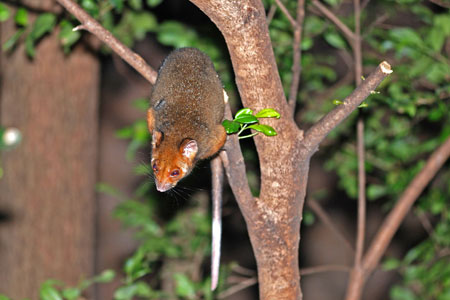Active Seasons



Roof Rat Appearance and Size Facts
Roof rats have gained notoriety for their versatility, resilience, and the many problems they pose. These arboreal rodents thrive in a variety of environments from urban to rural and are frequently found in attics, trees, and elevated spaces within residential and commercial structures. Due to their ability to adapt, roof rats are viewed as significant pests that often require professional pest control services. Some key features of roof rats include:
- Brownish color. Roof rats are usually some gradient of brown, black, and white.
- Pointed nose. Roof rats’ heads are pointed with large eyes and prominent ears.
- Up to eight inches in length. Roof rats are smaller than Norway rats.
- Long, scaly tail: You can spot a roof rat by its tail, which is longer than its body.
Identifying Roof Rats From Other Rodents
Roof rats are often confused with other rodents, with the most common culprit being the Norway rat. However, they can be distinguished by their long tails, more slender bodies, and pointed noses. Roof rats are also generally smaller with body lengths rarely exceeding eight inches, not including their lengthy tails.
Moreover, roof rats are usually found in elevated spaces or trees—hence their name. This sets them apart from the more ground-oriented Norway rats. Confusion between roof rats and other rodent species can lead to ineffective pest control. Accurately identifying the species at hand and properly approaching them is key, and nobody knows better than residential pest control and commercial pest control experts.
We provide roof rat control in the following locations and their surrounding areas:

Behavior and Habitat of Roof Rats
Roof rats in Florida are remarkably adaptable, thriving in various habitats. They’re mostly active at night, scavenging under the veil of darkness to evade predators and minimize human contact. As capable climbers, roof rats prefer elevated spaces, making homes in trees, attics, or higher floors of buildings rather than the ground-based habitats chosen by Norway rats.
Are roof rats dangerous? In short: yes. Roof rats can transmit several harmful diseases, including salmonella, dysentery, and hantavirus. They will bite if provoked, and they can transmit rat-bite fever to their victims. Along with physical danger, roof rats can also destroy your property. They gnaw on materials like wood, insulation, and wiring in your home’s foundation, making them a threat professionals should handle.

Signs of Infestation of Roof Rats
One of the most common signs of roof rats is droppings, typically found in attics, cupboards, or areas close to food sources. Chew marks on wood, electrical wiring, or food packaging are another giveaway, as roof rats tend to gnaw on various materials. A distinctive odor and nocturnal noises, particularly scratching or scurrying sounds in the walls or ceilings, can also often hint at the presence of roof rats in Florida.

Tips for Prevention of Roof Rats
If you want to know how to keep roof rats out of your home or business, the key is to make your environment less inviting. Start by sealing any holes or gaps in your foundation, particularly around the roof and eaves, to prevent easy entry. Regularly check for signs of gnawing on wood and electrical wiring, especially in elevated spaces like attics or lofts. Proper sanitation is also essential. Make sure to store food in sealed containers and dispose of waste in sturdy bins.
Similarly, eliminating water sources can deter roof rats. This includes fixing leaky pipes or faucets and not leaving standing water around. In your yard, maintain a clean environment by clearing away debris and trimming tree branches that are close to your home. Elevate stored items like firewood or gardening tools off the ground and keep them away from the walls of your building to reduce potential nesting sites.
Getting Rid of Roof Rats
The presence of roof rats can be alarming, unsettling, and even dangerous. In cases where roof rats have taken up significant residence, your best course of action is to seek professional pest control services. Rodent control experts can help you correctly identify and gauge roof rat infestation put an effective rodent control plan into place, and even help you prevent future infestations.
Effective Roof Rat Control Solutions
Dealing with roof rats in your Florida home or workplace? Don’t panic—just call Hulett! With more than 50 years of industry experience, Hulett Environmental Services is a trusted provider of rodent control in Florida and assistance with many other pest problems.
When you bring in the help of our friendly technicians, you can rest assured you’re working with experienced professionals. We utilize tested pet-friendly treatments and approaches to take care of your issue swiftly and restore your peace of mind. Looking to get started? Request your free inspection or give us a call to learn more about our services for roof rats in Florida! We even office weekend and evening services, so you can resolve roof rat problems right away.


